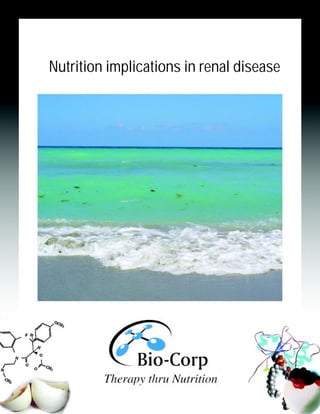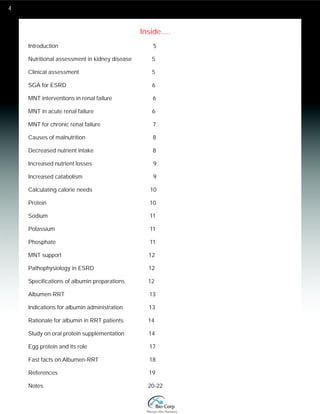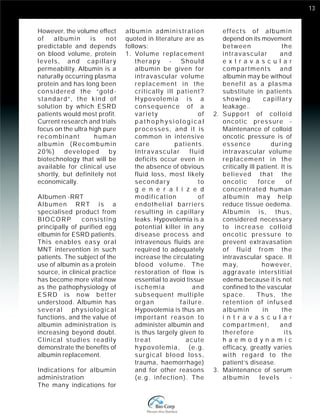Management of nutrition in patients with renal failure is challenging as malnutrition occurs in up to 40% of such patients and is associated with increased morbidity and mortality. Malnutrition has multiple contributing factors, including decreased food intake due to gastrointestinal symptoms. Providing appropriate calorie and protein intake tailored to the patient's stage of kidney disease is important to permit adequate nutrition without unnecessary restrictions. Nutritional assessment, monitoring guidelines for calories, proteins and minerals, and specialized nutrition support are crucial for managing the nutrition of renal failure patients.





![6
be needed. Diarrhoea is a
common complaint in diabetic
dialysis patients. Constipation
may occur due to fluid
restrictions, medications
required, or restriction of
foods that help relieve
constipation, such as prune
juice. Dental health will ensure
that patients get the nutrition
they need. This is particularly
important for dialysis patients
who require more protein.
Most protein foods are of
animal nature, which may
require more dentition. If
chewing problems continue,
alternative protein foods that
are easier to chew may need
to be considered.
Subjective Global Assess-ment
of Nutritional Status
of Patients [SGA] with
Chronic Renal Insuffi-ciency
and End Stage Re-nal
Disease
Subjective Global Assess-ment
[SGA] that refers to the
overall evaluation of a patient
by an experienced clinician, is
inexpensive, can be per-formed
rapidly, requires only
brief training, gives a global
score of nutrition and is repro-ducible.
It correlates the sub-jective
and objective aspects
of medical history and physi-cal
examination and also sat-isfactorily
agrees with objec-tive
methods of assessing
malnutrition. SGA is done us-ing
the 7 variables derived
from medical history and
physical examination with
each variable then scored
from 1-7, depending on the
severity.
MNT interventions in renal
Failure
Protein requirements for
patients with renal failure are
dependent on the acute or
chronic nature of the renal
failure and the presence and
type of dialysis. The nutritional
status and adequacy of
current intake of the patient
should also be considered.
Adults with chronic renal
failure who are not receiving
dialysis can usually maintain
a neutral nitrogen balance
consuming 0.6 g of protein per
kilogram if adequate calories
are ingested and most of the
protein is of high biological
value. A reduced protein
intake may decrease uremic
symptoms and delay the need](https://image.slidesharecdn.com/rrt-140912010441-phpapp02/85/Rrt-6-320.jpg)
![7
for dialysis in a stable patient
with chronic renal insufficiency.
However, a reduced protein
intake is not advisable in the
setting of significant
malnutrition, or inadequate
calorie intake. The frequent
occurrence of malnutrition in
patients with renal failure, and
the consistent association
between markers of
malnutrition and poor
outcome in this population
emphasize the need for
appropriate and timely
nutrition intervention.
Following physiologic and
metabolic imbalances are
commonly observed but what
is noteworthy is that all stages
of CKD benefit from diet
m o d i f i c a t i o n . N u t r i t i o n
assessment and counseling
with the patient and family is
advisable; but it is the
consistent follow-up, with
modification of the nutrition
plan as clinical status
changes, that is essential.
MNT for Acute Kidney
Injury
There is no data to suggest
that a protein restriction is of
any benefit in the setting of
acute renal failure associated
with severe illness or multi-organ
dysfunction. In patients
who are acutely ill with
increasing uremia, there is a
temptation to focus on the
protein content of nutrition
support as a major contributor
to uremia.
Acute Kidney Injury [AKI] also
known as Acute renal failure
may require some diet
modifications if the patient is
still dialyzing or while
recovering from kidney failure.
These nutritional needs must
be based on the patient’s
medical condition, degree of
malnutrition, current laboratory
data, fluid status, and type and
frequency of dialysis. As a
result, diet modifications
require continual reevaluation.
Once dialysis is no longer
needed, or kidney function
returns, many diet restrictions
required while in renal failure
may no longer be needed—
such as potassium,
phosphorus, or fluid
restriction.
MNT for Chronic Kidney
Disease
CKD pogresses through
various stages and
progression from CKD stage
I to End Stage Renal Disease
is marked by irreversible and
complete loss of kidney
functions. A better
understanding of alterations in
physiologic processes and
their impact on nutrition status
helps achieve better patient
management. Thus , with the
advent of CKD, progression to
ESRD is natural and is
associated with huge
imbalance of metabolic
processes in the body. These](https://image.slidesharecdn.com/rrt-140912010441-phpapp02/85/Rrt-7-320.jpg)


![10
· Underlying condition
and treatment plan
· Presence of other
chronic diseases
· Patient - goals for care
· Advanced directives
The diet format for predialysis,
chronic kidney disease, acute
renal failure, or dialysis
patients is based on the
popular National Renal Diet of
USA. It is based on grouping
foods of similar nutrient value.
The outlook at the dietary
management of such patients
is compounded by the fact that
majority of these patients have
very poor appetite and
metallic taste in mouth
because of inadequate
creatinine and urea clearance
rate. Besides, there are 10
key tasks to attend to:
1 Iron to increase
2 Potassium to decrease
3 Sodium to decrease
sometimes and increase
at other time
4 Vitamin C to increase
5 Protein to increase BUT
6 Not to increase the
phosphorous levels !!!!!
7 Calcium to increase
8 Vitamin D to increase
9 Balance with adequate
calories and
Carbohydrates
10 Check and provide
adequate source of
glutamine, arginine and Ù-
3 fatty acids.
Calculating calorie needs
Generally, caloric calculations
should be done with actual
edema-free body weight,
determined post-dialysis for
hemodialysis, and “post-drain”
for peritoneal dialysis.
The National Kidney
Foundation recommends that
when patients are 95% or
115% of the median
standard weight (as
determined from the
NHANES II data), that an
adjusted body weight be used.
Adjusted body weight is
calculated as follows:
Adjusted weight = ideal weight
+ [(actual edema-free weight
– ideal weight) x 0.25]
Protein
The amount of protein a patient
requires will depend upon their
stage of CKD. Dialysis also is
drain to body proteins and
daily losses can occur to an
extent of 20 to 30 g in 24 hr
continuous peritoneal dialysis
[= 1 g / hr]
Source: Krause Mahan,
2000
Protein – Pre-Dialysis
Patient
Protein restriction is a part of
the Pre-ESRD diet. Since
there is a decline in the
patient’s ability to clear the
blood from the protein
metabolites due to the loss of
kidney function, a high protein
diet causes accumulation of
metabolites in the blood.
Increased protein waste
products in the blood leads to
undesirable symptoms such
as nausea, vomiting, loss of
appetite, malnutrition and
further decline in kidney
function. The recommended
protein requirement is 0.6-0.8
grams per kilogram of ideal
body weight.
Protein – Dialysis Patient
If the disease progresses to
chronic kidney failure
(ESRD), the protein restriction
is removed and additional
protein intake is
recommended. It is
recommended that dialysis
patients increase their protein
intake to 1.2 to 1.4 grams per
kilogram of their ideal body
weight.
Whole body Amino acid
turnover kinetics:
Mass balance equation:
(Non dialyzed individuals)
Q = B+I = C+S
Where
Q=AA(leucine) flux,
B = Breakdown,](https://image.slidesharecdn.com/rrt-140912010441-phpapp02/85/Rrt-10-320.jpg)




![15
(hypoalbuminemia).
While malnutrition and
hypoalbuminaemia have
been used synonymously,
there is strong evidence
that inflammation also
plays a role in determining
the level of serum albumin
in such patients. Both C-reactive
protein [CRP] and
cytokine levels are
predictive of temporary
variation in albumin level as
well as survival. This is
surprising but true
considering the fact that
CRP levels are raised in
dialysis patients for only a
fraction of the time.
The evidence for protein
catabolism during and after
each haemodialysis
treatment has been
recently reviewed as it
impacts other proposed
adverse effects of HD,
including cytokine
activation, clotting, and
inflammatory responses to
pyrogens that have been
implicated as a cause of
patient morbidity and
mortality. Animal studies
suggest that decreased
protein synthesis is likely
mediated by the significant
decrease in plasma amino
acid concentrations which
occurs during dialysis
treatment. Consequently,
protein needs are higher in
CHD patients than healthy
adults, but nutrient intake is
frequently much lower. With
malnutrition likely, the
patient’s amino acid pool is
already lacking, further
compromising protein
synthesis. Hence, the
relationship between
dialysis dose and
nutritional intake and the
potential nutritional
benefits of albumin on
more frequent dialysis as
well as survival rates
clearly demonstrate that
albumin supplementation to
such patients cannot be
overlooked. In summary,
CKD and HD / CAPD
comes with a huge burden
of problems. Protein is the
major issue as it is directly
related to the mortality and
morbidity ratio in ESRD
patients. There are number
of protein sources available
in nature. However the
protein that satisfies
following criteria saves and
extends life and this is
where albumin f i t s in
perfectly.
A recent study by
Veeneman et al.
consistently revealed that
the -ve protein balance of
HD can be easily reversed
by feeding protein. The
investigators in this study
agreed that proteolysis is
not increased by dialysis
and that the catabolic
effect of dialysis is caused
by 2 factors:
· Reduced synthesis
of protein, and
· I n c r e a s e d
proteolysis and loss
of amino acids in the
dialysate.
The increased breakdown
of muscle protein during
dialysis is apparently
compensated for by liver
uptake and synthesis,
resulting in no net
proteolysis, provided the
reduction in amino acid
concentration caused by
losses in the dialysate is
compensated by feeding
the patient. In this way, in
stable hemodialyzed
patients there can be little
evidence for a major
catabolic effect of the
dialysis itself. All ESRD
patients continue to
manifest signs of
malnutrition precipitated by
dialysis but responding well
to dietary supplements.
Patients who are
“overnourished” with high
BMI values have a better
prognosis as discussed
above.
Study on oral protein
supplementation in CAPD
patients
However, dietary
supplements especially
those with high protein
value have been the subject
of criticism because of their
cost, and the theoretical
argument that they cause
a proportional reduction in
the patient’s normal dietary
intake, resulting in a net
zero benefit. This question
was addressed by a study
where the aim was was to
evaluate the effect of oral
administration of an egg
albumin-based protein
supplement on the](https://image.slidesharecdn.com/rrt-140912010441-phpapp02/85/Rrt-15-320.jpg)


![18
efficiently than any other
known dietary protein. Egg
protein possesses the
highest possible Protein
Digestibility Corrected
Amino Acid Score
(PDCAAS), the most
commonly used measure
of protein quality [not
forgetting milk and soya
protein]. Research
suggests that diets higher
in animal protein and lower
in carbohydrates can help
ESRD patients maintain
muscle mass during
dialysis, thus improving
body composition. This is
of great importance since
lean body mass is the
single most important
determinant of resting
energy expenditure.
Egg albumin: Easy and
abundantly available
aource
In one evaluation, the most
important predictors of
serum albumin were the
oral egg albumin-based
supplement administration
and protein intake (p
0.05); secondary
predictors (p = 0.06) were
peritoneal transport rate
and MAMA (Mid Arm
Muscle Area). Oral
administration of the
albumin supplement and
protein intake were the
most significant predictors
of serum albumin at the end
of follow-up. This oral
supplement may be a safe,
effective, and cheap
method to improve
nutritional status in
peritoneal dialysis
patients.30
Fast Facts: Albumen-
RRT
Albumen-RRT contains
egg albumin, which is an
excellent source of all the
essential and non-essential
amino acids. Albumen-RRT
is stable as a ready to use
powder form at room
temperature. As such, the
product can be mixed with
food as sprinkles or liquid,
or taken, as is available–
providing 7grams of
protein in only 10g. of the
powder.
Conclusions
The benefits provided by
orally administered
Albumin in ALBUMEN-RRT
are as good as expensive
parenteral albumin at a
fraction of the cost. Such a
supplementation enables
the attending clinician to
meet a l l the exacting
demands of the dietary
management of ESRD
patients. By not only
meeting the protein
demands but also the
needs for intervention into
the mineral requirements,
ALBUMEN-RRT is a unique
product that is designed
specifically for such
patients.](https://image.slidesharecdn.com/rrt-140912010441-phpapp02/85/Rrt-18-320.jpg)





